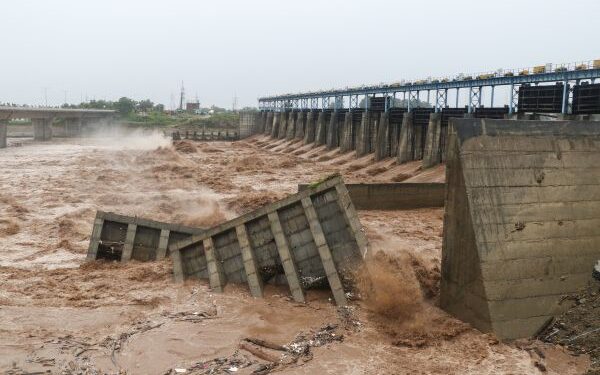It was a rainy afternoon in Upper Bazar, Qazigund. The kind of rain that does not just fall but lingers, soaking everything with a quiet persistence. A group of us had taken shelter in a small hotel, its steaming cups of kehwa and chai offering comfort against the damp chill. Rainwater pattered rhythmically on the tin roof as we sat huddled around tables. Some of us talked about the rain; others had their eyes glued to mobile screens, scanning news updates about rising water levels in the Jhelum and the flood situation unfolding in Jammu.
The conversation was animated, if not anxious. People spoke about riverbanks swelling, low-lying areas already inundated, and the troubling memories of previous floods—especially the catastrophic one of 2014, when nature’s fury left Kashmir devastated. Amid the chorus of complaints and blame, one elderly man, his beard speckled with grey and his voice firm but calm, made a remark that silenced the room.
“This is our doing,” he said. “We have made encroachments everywhere. We have stolen the river’s space and now it is taking it back. Do not blame the government or nature alone. We should vacate this encroached land ourselves. Nature is unhappy with us, and until we correct our mistakes, there will be no happiness.”
His words were heavy, almost prophetic. They carried the weight of truth and self-realization that is often missing in public discourse. What followed was a remarkable silence, as if everyone was forced to confront their complicity in a collective crime against nature.
This small gathering in a bazar tea shop reflected something larger—a truth about our relationship with land, water, and the environment. It was not just about floods, nor just about the government’s inability to manage disasters. It was about how society, at large, has become a culprit in the making of its own tragedies.
The River’s Voice: A History of Encroachment
The Jhelum, once called the lifeline of Kashmir, has always been more than just a river. It has nourished fields, sustained livelihoods, carried boats, and defined the cultural imagination of Kashmiris. But over decades, its banks have been narrowed by human greed. Houses, shops, hotels, even entire colonies have been built where the river once flowed freely.
Encroachment is not a story unique to the Jhelum. Across India, rivers have been strangled by unauthorized constructions. Floodplains have been turned into residential colonies, marshlands into commercial hubs, and irrigation channels into garbage dumps. Rivers like Yamuna in Delhi, Tawi in Jammu, Sabarmati in Gujarat, and countless smaller streams across the subcontinent have been forced to shrink, suffocated by human intrusion.
Yet, the tragedy in Kashmir feels sharper because of the valley’s geographical vulnerability. Surrounded by mountains and dependent on a delicate network of rivers, streams, and wetlands, the region has always required careful ecological balance. Encroachment disturbs this balance, leaving the land more prone to devastating floods.
When people build on land that is officially recorded as gair mumkin nallah or gair mumkin koul—land legally reserved for water bodies—they are not just violating the law. They are challenging nature itself. The river, sooner or later, reclaims what belongs to it. The floods, then, are not “natural disasters” in the purest sense; they are human-made calamities waiting to happen
The Blame Game: Generational Divide
In our tea hotel that rainy afternoon, the generational blame game unfolded as expected. Some younger people argued that encroachments were the result of weak governance, corruption, and lax enforcement. They pointed fingers at municipal officials, revenue officers, and politicians who looked the other way when houses sprouted illegally on floodplains.
But the elderly man refused to let society off the hook. “Do not forget,” he said, “it was the new generation—us, our children—who chose to build on land we knew belonged to the river. We did not resist temptation. We wanted a shop, a house, a hotel, and we grabbed the land without thinking of consequences.”
This generational debate is telling. On one hand, young people argue that systemic corruption encouraged the menace. On the other, the older generation reminds us that collective morality has collapsed; greed became stronger than wisdom. Both arguments are valid, but together they reveal an uncomfortable truth: encroachment is not the crime of one generation, one class, or one government. It is the cumulative failure of society as a whole.
Nature’s Revenge: Floods as a Warning
Floods, when they arrive, do not discriminate between the rich and poor, between legal and illegal constructions. They sweep across homes, hotels, fields, and shops alike. Yet, those who have built closest to the river’s heart—on its banks, in its natural channels—are the first to face destruction.
The 2014 floods were a brutal reminder. Entire neighbourhoods in Srinagar, Pulwama, and Anantnag were swallowed by water. Bridges collapsed, livelihoods were destroyed, and thousands were left homeless. Experts later pointed out how wetlands that once absorbed excess water had been filled with concrete. Rivers that once had broad shoulders to carry floodwaters were forced into narrow channels.
But did society learn? Only partially. While government agencies made promises of flood mitigation, embankments, and dredging, new constructions kept mushrooming. The greed for land did not pause, even after the tragedy.
In this sense, every fresh spell of heavy rain becomes a warning. Each rising water level in the Jhelum is not just a natural event but a reminder that nature does not forget, nor does it forgive.
Self-Realization vs. State Action
The old man’s advice in Qazigund—“we should vacate encroached land ourselves”—sounds idealistic, even impractical in today’s world. But it carries a moral truth. If society truly recognized the dangers of encroachment, voluntary relocation might save lives in the long run.
Yet, in reality, people seldom move unless forced. Here lies the responsibility of the state. Evictions, demolitions, and strict enforcement are not popular measures, but they are necessary. Governments must act not only after floods but also before disasters strike.
The problem, however, is that enforcement often collides with politics. Demolishing a colony built on encroached land might anger voters. Evicting shopkeepers or hoteliers could invite backlash. This political hesitation allows encroachments to thrive, making the government complicit in the crime.
What is needed, therefore, is a twofold approach:
- Voluntary Morality: Citizens must understand that living on encroached land is not just illegal but suicidal. A flood will not recognize court orders or ownership documents; it will follow the law of nature.
- Strict Governance: The government must treat rivers, wetlands, and floodplains as sacrosanct. Encroachments must be identified, marked, and removed with consistency, even if unpopular.
Beyond Blame: A Path Forward
As the tea cups in Qazigund grew empty, our conversation shifted from blame to solutions. Could we imagine a future where rivers flowed freely again, where wetlands were restored, and where encroachments were reversed?
The path forward requires courage, both political and social:
Mapping and Digitization: Every riverbank, stream, and wetland must be mapped using modern technology and linked to land records. Transparency reduces corruption.
Community Responsibility: Local committees, including elders, should be empowered to monitor encroachments. A social stigma must attach to illegal construction.
Compensation and Relocation: For those genuinely poor families who have settled on dangerous lands, humane rehabilitation is necessary. Punishing the vulnerable while sparing the powerful would deepen injustice.
Cultural Awareness: Schools, mosques, and community platforms must stress the sacredness of rivers. Environmental awareness must become part of cultural identity.
Disaster Preparedness: Instead of reacting to floods, governments must prepare communities through early warning systems, embankments, and flood zoning.
Listening to Nature
When we left the tea shop in Upper Bazar that day, the rain had not stopped. It fell harder, drumming against roofs, flowing into drains, swelling the riverbanks. The words of the elderly man echoed in my mind: “Nature is unhappy with us. We must make it happy again.”
The truth is simple yet profound. Encroachments are not just about land grabs; they are about broken trust between humans and nature. By taking what does not belong to us, we invite nature’s wrath. The floods, the landslides, the erosion—they are not acts of cruelty by nature but acts of justice.
The rivers of Kashmir, like rivers everywhere, are speaking to us. They whisper before they roar. They warn before they destroy. The question is: will we listen?
Until we do, every drop of rain will carry both beauty and fear. And every flood will remind us that in the fight between man and nature, the river always wins.




